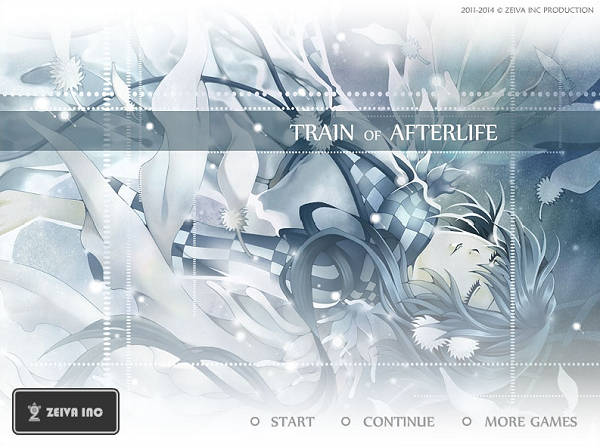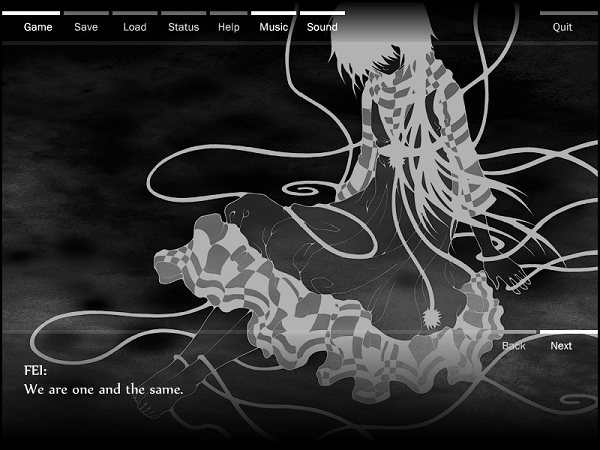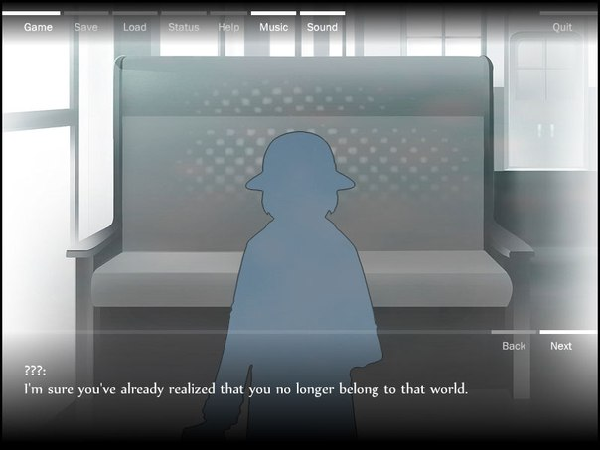
When you are picking up a visual novel and it has a name like “Train of Afterlife”, then you know right away that you are not in for a jolly, fun time. It’s an emotional tale about death and loss that was originally released in 2012 and saw a re-release on Steam just recently.
Right off the bat, the game starts on a somber note; your character awakens in a train with no memories and not even a physical form. You are greeted by a shadow, “Little Mary”, who explains that you have left the world of the living and find yourself on the titular Train of Afterlife. Everyone on this train is the same as you, but no worries, after just twelve hours you will simply disappear and presumably go to heaven, hell, or whatever else awaits.
Besides the kind and caring Mary, there are three other passengers and the game forces you to introduce yourself to all of them. Each character is associated with a seat where they will usually be found and after you finished chatting them up, a sixth entity appears. While your character automatically adapts the name “Wind”, this ghost calls itself “Wing”, and seems more connected to you than all the others. No one else on the train seems to be aware of Wing, however, and it doesn’t take long until he or she starts displaying a somewhat eerie and mysterious side. The characters are actually the best part of the story for me and the brief friendships you build up with them do a lot to alleviate the sad nature of the plot, making the moment they disappear all the more tragic.

After this introduction, the clock starts to tick for you. Each “turn” takes up one of your twelve hours and you have to speak with a specific person on the train in order to advance. At first this varies, but after a while this person will always be “Bluebird”, who spends all his (or her) time reading tarot cards in a desperate attempt to find out more about the past. Until you go speak with the correct person, you are free to converse with everyone else to discover more of the plot. During set hours, the dialogue of your fellow ghosts will even feature choices that alter the course of the story.
The game has four statistics in place: Hour, Awareness, Enlightenment, and Darkness. Hours proceed automatically as you finish turns, but the other three statistics are largely dependent on your choices and these influence the ending you will get at the end of the road. Light is generally the more social path and means you are more willing to accept death, whereas darkness has you react somewhat rude and cling to your past life. Awareness is a bit more difficult to explain and like with the hours, it mostly builds up as you play as a result of participating in the mandatory tarot sequences.
These tarot cards provide you with flashbacks and help you solve the mystery around who you used to be and what might have happened. Regrettably, the cards are out of order and written to be deliberately confusing, so it’s difficult to figure out how everything and everybody in these scenes connect. After you have drawn your final tarot card during the 11th hour, the game will decide your ending based on what statistics are the most prominent.
All in all, I think rather highly of the story and the writing is pretty strong too, relying mostly on direct conversations that flow well and are easy to read. Even someone who isn’t too keen on reading could probably get into this as a result. There are some issues, however, most notably the effect created by the different endings. In total there are nine, but when you play it for the first time, you are only able to get four. After you get the initial four once, you will unlock “Wing’s Path”, which isn’t as exciting as it sounds. All it does is double the enlightenment and darkness points you get, effectively unlocking the remaining five endings. This means you will have to read the same story at least five times before you even get the chance to figure out the mystery.

I didn’t mind the first few replays, since I kept discovering new things by making different decisions and Wing’s path unlocks some extra options and dialogue, yet after that I grew very fond of the skip function that breezes through the text until you hit a choice. It can also be discouraging that most endings you are likely to get feel like you failed, some are even creepy and unsettling. In fact, of the seven endings I got, only one was happy in tone and that just so happens to be the most difficult one to get. The story is pretty short, so the repeated sessions are necessary to get your money’s worth; reading at a decent pace, you should be able to finish your first session in about 45 minutes. I went for the best ending and ended up amassing just under 5 hours, which is a lot better.
All of that is the novel part of this visual novel, so how do the visuals hold up? Well, initially I wasn’t too fond of it. The game mostly takes place in the train and all the characters are drawn as static shadows with no alternate poses, so there is not much to look at. The flashbacks and endings do take you out of the train and provide some nice variety, but some of the pictures used in them are brighter and fuller in color, making them look somewhat out-of-place. However, it really grew on me as I replayed the game a few times and there are some nice touches to be found. For example, Wing is a shadow too, but as you read tarot cards and thus regain your memories, he or she will gradually be filled up with color and detail. As mentioned before, if you unlocked Wing’s Path, then the identity of the other characters can also be revealed and you get to see their design in color too, a nice reward after spending so much time with them. The melancholic soundtrack that plays throughout the game supports the tone of the novel perfectly and fits well with the images used during the tarot scenes.
While I dislike how often you have to start over again to get all the endings, and the password system is a bit obnoxious to use, I thoroughly enjoyed my time with Train of Afterlife. It’s written in a way that makes it accessible to those who may not be a fan of the genre, while also containing plenty of clever hints and symbolism for the more serious people to look for. Decisions are also plentiful, so while it isn’t “gameplay” per say, it still feels like you are a part of the story and influencing your experience. If you are interested in a psychological mystery drama that has bits of horror sprinkled on it, then Train of Afterlife is one of the finest visual novels currently available on Steam and comes wholeheartedly recommended.
 (9 / 10)
(9 / 10)
Amazing
 (9 / 10)
(9 / 10)



